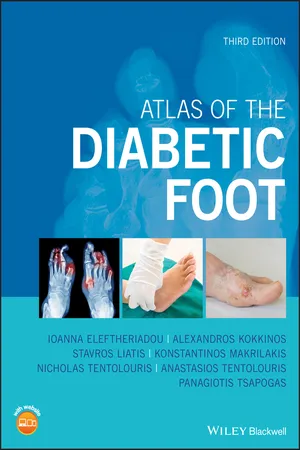
Atlas of the Diabetic Foot
- English
- ePUB (mobile friendly)
- Available on iOS & Android
About this book
The revised and updated third edition of the essential guide to the diagnosis and treatment of the diabetic foot
The revised third edition of the Atlas of the Diabetic Foot is an updated guide to the information needed for the prevention and treatment of diabetic foot problems with the aim of reducing amputations. In addition to offering the theoretical knowledge, the book is filled with more than 500 color photos from real-life cases. The cases explore a wide-variety of foot issues and the text includes information about differential diagnosis and treatment. The authors—noted experts in the field—describe the epidemiology, pathophysiology and classification of diabetic foot ulcers. In addition, the book highlights the diagnosis of the main risk factors for the diabetic foot, namely diabetic neuropathy, peripheral arterial disease and the anatomic deformities of the lower extremities.
The updated third edition, include 5 videos that clearly demonstrate the methods of examination for diabetic neuropathy and peripheral arterial disease. The text incldues methods of callus removal and debridement as well as offloading. In addition, it contains information on how a total contact cast is constructed. This essential resource:
- Contains a full colour presentation of diabetic foot cases
- Explains the prevention and treatment of diabetic foot problems in a revised and updated edition
- Includes a larger format that allows for a better quality images
- Offers a companion website with high-resolution digital files of photographs of the case studies presented
- Presents a multidisciplinary approach appropriate for a wide audience foot and diabetic professionals
Written for diabetes specialists, endocrinologists and diabetic nurse specialists, podiatrists and podiatry nurse specialists, Atlas of the Diabetic Foot offers the information needed to help with the prevention, diagnosis and management of the diabetic foot.
Frequently asked questions
- Essential is ideal for learners and professionals who enjoy exploring a wide range of subjects. Access the Essential Library with 800,000+ trusted titles and best-sellers across business, personal growth, and the humanities. Includes unlimited reading time and Standard Read Aloud voice.
- Complete: Perfect for advanced learners and researchers needing full, unrestricted access. Unlock 1.4M+ books across hundreds of subjects, including academic and specialized titles. The Complete Plan also includes advanced features like Premium Read Aloud and Research Assistant.
Please note we cannot support devices running on iOS 13 and Android 7 or earlier. Learn more about using the app.
Information
1
Introduction
1.1 Definition
1.2 Epidemiology
| Reference | Country | Population‐ or clinic‐based | Prevalence (%) | Incidence | ||
| Foot ulcers | Amputation | Foot ulcers | Amputation | |||
| Borssen et al. (1990) | Sweden | Population | 0.75 | – | – | – |
| McLeod et al. (1991) | UK | Clinic | 2.6 | 2.1 | – | – |
| Walters et al. 1992 | UK | Population | 7.4 | ‐ | – | – |
| Moss et al. (1992) | USA | Population | – | 3.6 | 10.1a | 2.1a |
| Bouter et al. (1993) | The Netherlands | Population | – | – | 0.8b | 0.4 |
| Siitonen et al. (1993) | Finland | Population | – | 0.5 | ||
| Pendsey et al. (1994) | India | Clinic | 3.6 | – | – | – |
| Kumar et al. (1994) | UK | Population | 1.4 | – | – | – |
| Humphrey et al. (1996) | Nauru | Population | – | – | – | 0.76 |
| Abbott et al. (2002) | UK | Population | 1.7 | 1.3 | 2.2 | – |
| Mueller et al. (2002) | The Netherlands | Population | – | – | 2.1 | 0.6 |
| Centers for Disease Control and Prevention (2003) | USA | Population | 11.8 | – | – | – |
| Lavery et al. (2003) | USA | Population | – | – | 6.8 | 0.6 |
| Manes et al. (2002) | Balkan region | Clinic | 7.6 | – | – | – |
Table of contents
- Cover
- Table of Contents
- Preface to the Third Edition
- Preface to the Second Edition
- Preface to the First Edition
- Acknowledgements
- About the Companion Website
- 1 Introduction
- 2 Diabetic Neuropathy
- 3 Anatomic Risk Factors for Diabetic Foot Ulceration
- 4 Other Foot‐Related Risk Factors
- 5 Skin and Systemic Diseases with Manifestations in the Feet
- 6 Neuropathic Ulcers
- 7 Peripheral Vascular Disease
- 8 Ischemic and Neuro‐Ischemic Ulcers and Gangrene
- 9 Heel Ulcers
- 10 Charcot Foot
- 11 Infections
- 12 Methods of Prevention
- 13 Methods of Ulcer Healing
- 14 Amputations
- Appendix
- Index
- End User License Agreement